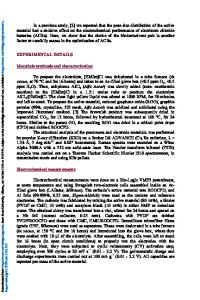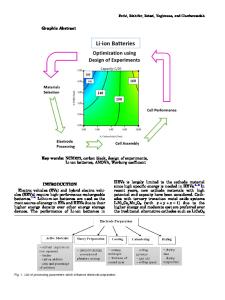Cathode material for sodium-ion batteries based on manganese hexacyanoferrate: the role of the binder component
- PDF / 783,560 Bytes
- 9 Pages / 595.276 x 790.866 pts Page_size
- 46 Downloads / 300 Views
ORIGINAL PAPER
Cathode material for sodium-ion batteries based on manganese hexacyanoferrate: the role of the binder component E. V. Shkreba 1 & R. V. Apraksin 2 & E. G. Tolstopjatova 1 & V. V. Kondratiev 1 Received: 26 April 2020 / Revised: 25 June 2020 / Accepted: 27 June 2020 # Springer-Verlag GmbH Germany, part of Springer Nature 2020
Abstract Sodium manganese hexacyanoferrate (NaMnHCF) was synthesized by a hydrothermal method and investigated as a cathode material for sodium-ion batteries. The morphology and the structure of NaMnHCF were investigated by X-ray diffraction, scanning electron microscopy, and EDX analysis. New composition of NaMnHCF cathode material for sodium-ion batteries with eco-friendly water-based binder consisting of conducting polymer poly-3,4-ethylenedioxythiopene/polystyrene sulfonate (PEDOT:PSS) dispersion and carboxymethyl cellulose (СМС) was proposed. The electrochemical properties of NaMnHCF cathode material with conductive polymer binder were investigated by cyclic voltammetry and galvanostatic charge-discharge, and the results were compared with the performance of a conventional PVDF-bound material. It was shown that the initial discharge capacity of electrodes with conductive binder is 130 mAh g−1, whereas the initial discharge capacity of PVDF-bound electrodes was 109 mAh g−1 (both at current density 120 mA g−1, values normalized by NaMnHCF mass). The material with conductive binder also has better rate capability; however, it is losing in cycling capability to the electrode composition with conventional PVDF binder. Keywords Sodium manganese hexacyanoferrate . Sodium-ion batteries . PEDOT:PSS . Binders . Conducting polymer . Carboxymethyl cellulose
Introduction As is well known, lithium-ion batteries (LIB) are now the leading electrochemical energy storage devices that are widely used in numerous applications [1, 2]. However, the rapid growth in demand of electrochemical power sources and the worldwide concern on limited lithium resources has raised an interest in elaboration of new generation of metal-ion batteries [3–6]. Therefore, last decade a lot of effort was directed on the investigations of new alternative intercalation materials as cathode host materials suitable for sodium, potassium, and Dedicated to Professor Fritz Scholz on the occasion of his 65th birthday in recognition of his numerous contributions to fundamental and applied electrochemistry. * V. V. Kondratiev [email protected] 1
Institute of Chemistry, Saint Petersburg State University, 7/9 Universitetskaya nab., Saint Petersburg, Russia 199034
2
The Ioffe Institute, Russian Academy of Science, 26 Politekhnicheskaya str., Saint Petersburg, Russia 194021
magnesium ion storage for corresponding metal-ion batteries [1–6]. Among various energy-storage inorganic materials proposed, the transition metal hexacyanoferrates which possess zeolite-like structures with channels accessible for cations larger than lithium have been recognized as a perspective class of active electrode materials for metal-ion batterie
Data Loading...











